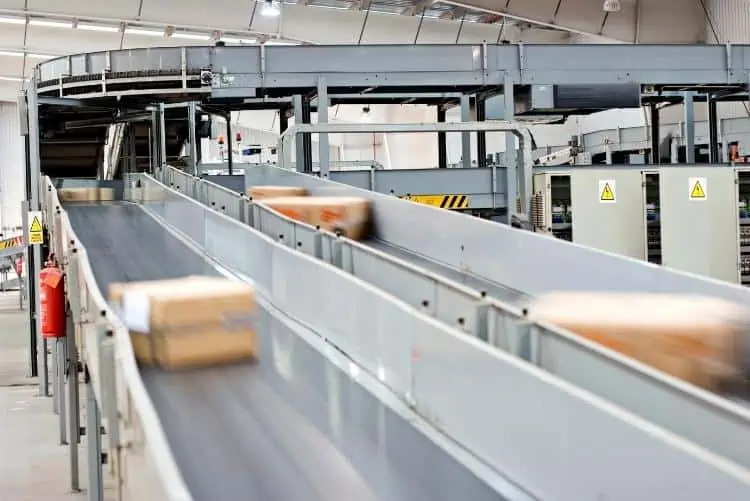Conveyor belts are one of the most efficient and versatile ways to transport various industries’ products, materials, and components. They have played a critical role in production lines across different sectors, including automotive, food and beverage, pharmaceuticals, and many more. The primary purpose of a conveyor belt is to convey or move items from one location to another in a continuous and automated process.
This blog will examine the evolution, benefits, and applications of conveying in the manufacturing industry and how conveyor belts have revolutionized production. We will also investigate the different types of conveyor belts and their applications, including the benefits of using them in various industries.

The History of Conveyor Belts
Conveyor belts have been in the industry since the 19th century, and their design has evolved significantly. The first conveyor belt was created in 1892 by Thomas Robins, made of a rubber and canvas material. Previously, it used to transport coal and revolutionized the mining industry. Over the years, conveyor belt designs have been made from various materials such as PVC, nylon, rubber, and steel for different industries.
In the early years of conveyor belt use, they were primarily in the mining industry to transport coal and other materials. The first conveyor belt was made of rubber and canvas, powered by hand-cranked spindles. It was a revolutionary invention that made transporting goods faster, more efficient, and safer than previous methods.
Evolution of conveyor belts
Over the years, conveyor belts have evolved significantly. Their uses are in various industries, including manufacturing, logistics, and agriculture. The materials used to make conveyor belts have also changed. For example, in the 1950s, PVC replaced rubber as the primary material for conveyor belts. Other materials, such as nylon, steel, and silicone, are commonly used to make conveyor belts.
Several conveyor belts are available today, each designed for a specific purpose. Some standard conveyor belts include flat, modular, cleated, and troughed belts. Each conveyor belt type has unique features and benefits that make it suitable for specific applications.
Types of Conveyor Belts:
Conveyor belts come in different types and configurations, and their design varies depending on the product, industry, and production requirements. Below are the common types of conveyor belts.
- Roller Conveyor Belt: This conveyor belt consists of rollers placed at fixed intervals to transport goods from one location to another.
- Belt Conveyor: The most common conveyor belt that uses a flat belt to transport products. The belt runs between two pulleys, and the items on the belt move along the length of the conveyor.
- Modular Conveyor Belt: This conveyor belt uses interlocking plastic modules to transport products. They are ideal for use in industries that require high hygiene standards, such as food processing.
- Inclined Conveyor Belt: An inclined conveyor belt transports items from one level to another at an angle. They are used to transport items between different floors in buildings.
- Screw Conveyor Belt: This conveyor belt has a rotating helical screw blade that moves items along the conveyor. They are commonly used in the agricultural industry to transport grains and other materials.
Applications of Conveyor Belts:
Conveyor belts are used in various industries and are crucial to efficiently running industrial operations. Below are some of the typical applications of conveying.
- Automotive Industry: Conveyor belts are widely used in the automotive industry to transport car components and assemblies along the production line. They transport items such as engines, transmissions, and other parts between workstations.
- Food and Beverage Industry: Conveyor belts are extensively used in the food and drinks industry to transport items and beverages along the production line. They transport items such as cans, bottles, and packaged foods.
- Mining Industry: Conveyor belts are used in the mining industry to transport materials from the mines to the processing plants. They transport items such as coal, ores, and other minerals.
- Pharmaceutical Industry: Conveyor belts are widely used in the pharmaceutical industry to transport medicines, capsules, and tablets along the production line. They transport items from one workstation to another, such as from the packaging station to the labeling station.
Benefits of Conveyor Belts:
Conveyor belts offer numerous benefits to the manufacturing industry and have revolutionized production. Below are a few benefits of using conveyor belts.
- Increased Efficiency: Conveyor belts enable the automation of the production process, making it more efficient and cost-effective. They reduce the need for manual labor and increase the speed of production.
- Improved Safety: Conveyor belts operate with minimal human intervention, which reduces the risk of accidents and injuries. They also have safety features such as emergency stop buttons and guards that protect workers from harm.
- Flexibility: Conveyor belts are highly versatile, and you can customize them according to the needs of different industries. They can transport items of different shapes, sizes, and weights, making them suitable for various production processes.
- Cost-Effective: Conveyor belts are cost-effective and provide a high return on investment for manufacturing industries. They reduce the need for manual labor, which saves on labor costs and increases production speed, which lowers production costs.
- Improved Product Quality: Conveyor belts ensure the uniformity of product quality by transporting items along the production line at a constant speed. It helps to minimize errors and defects in the manufacturing process.
- Increased Throughput: Conveyor belts enable the continuous flow of materials and products, increasing the production process’s throughput. It helps to meet production targets and improve productivity.
Conclusion:
Conveyor belts have played a critical role in manufacturing by revolutionizing production. They offer numerous benefits to different sectors, including increased efficiency, safety, flexibility, cost-effectiveness, product quality, and throughput. As the manufacturing industry evolves, conveying will remain a vital production component. Manufacturing companies must invest in high-quality conveyor belts designed to meet their needs. They must also ensure that the conveyor belts are regularly maintained and inspected to minimize the risk of breakdowns and downtime. By doing so, they can improve their production processes efficiency and productivity, ultimately leading to increased profitability and competitiveness in the market.



